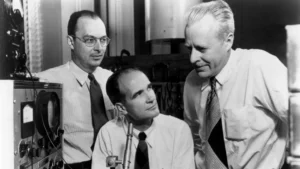Furthermore, we’ll trace the historical milestones that paved the way for the United States to become a global leader in semiconductor manufacturing and research. Additionally, we’ll examine the key players, visionary entrepreneurs, and groundbreaking discoveries that defined the evolution of Silicon Valley into a powerhouse of innovation. So, fasten your seatbelts as we embark on a journey through the heart of America’s technological revolution!
Follow us on Linkedin for everything around Semiconductors & AI
The United States: Pioneering the Path of Semiconductors
Overview:Moreover, the collaborative spirit among academic institutions, research laboratories, and private sector companies has been a driving force behind the United States’ semiconductor prowess. Additionally, government initiatives and funding have provided crucial support for research and development in this critical sector. This rich history of innovation and collaboration continues to shape the landscape of the global semiconductor industry.
Silicon Valley: Where Dreams Become Reality
The Birth of Silicon Valley:
In the heart of California, a region known as Silicon Valley, a revolution was sparked. The term “Silicon Valley” originated from the abundance of silicon used in the manufacturing of semiconductors, but it soon became synonymous with technological innovation. The valley’s rise as a global hub for innovation can be traced back to the 1950s when several factors converged to create a perfect breeding ground for creativity and entrepreneurship.
Trivia: The name “Silicon Valley” was coined in the early 1970s by a journalist named Don Hoefler, who used it in an article to describe the region’s burgeoning semiconductor industry.
History of VLSI: Transistor to System-on-a-Chip – techovedas
Government Initiatives and Policies: Fostering Semiconductor Growth
Furthermore, public-private partnerships have played a crucial role in driving innovation in the U.S. semiconductor sector. Collaborations between government agencies, academic institutions, and industry leaders have facilitated knowledge exchange and the sharing of resources, leading to the development of cutting-edge technologies. Additionally, incentives for research and development tax credits have encouraged private sector companies to invest in semiconductor innovation, further propelling the industry’s growth. This multi-faceted approach underscores the United States’ commitment to maintaining its leadership in semiconductor technology.
Trivia: The internet, which has become an integral part of our lives, originated from a research project funded by the U.S. government’s Advanced Research Projects Agency Network (ARPANET).
Government-Industry Collaboration: The Recipe for Success
Public-Private Partnerships:Moreover, government agencies have been instrumental in setting research priorities and providing funding for critical projects. This strategic alignment has propelled the U.S. semiconductor industry to the forefront of global innovation. Additionally, regulatory frameworks and intellectual property protections have created an environment conducive to technological advancement and investment. This synergistic relationship between the government and industry remains a cornerstone of the semiconductor sector’s continued success in the United States.
Trivia: The development of the first microprocessor, Intel’s 4004, was a result of a collaboration between Intel and Busicom, a Japanese calculator manufacturer.
Attracting Talent and Entrepreneurship: A Magnet for Innovators
Education and Immigration Policies:
The United States has long been an attractive destination for the brightest minds from around the world. The country’s renowned universities and favorable immigration policies have created an environment that attracts top talent, fostering a culture of innovation and entrepreneurship in the semiconductor industry.
Trivia: More than half of the founders of Fortune 500 companies, including those in the semiconductor industry, are immigrants or children of immigrants.
Conclusion: Leading the Semiconductor Revolution
The United States, with its technological dominance and the emergence of Silicon Valley, has been a driving force in shaping the semiconductor industry. Through government initiatives, collaboration, and a supportive ecosystem, the U.S. has fostered innovation and laid the groundwork for groundbreaking advancements in semiconductors.
As we move forward, the United States continues to be at the forefront of the semiconductor revolution, driving progress, and pioneering technologies that will shape our digital future.
Trivia: Founded in 1968, Intel, the largest semiconductor company globally, played a significant role in popularizing personal computers, which have since become a ubiquitous part of our lives.
In our next post, we’ll venture into the rising semiconductor powerhouse of China, exploring its ambitions, achievements, and the evolving dynamics of the global semiconductor industry. Stay tuned!



